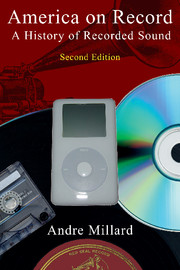Book contents
- Frontmatter
- Dedication
- Contents
- Preface to the second edition
- Preface to the first edition
- Introduction
- Part One The acoustic era
- Part Two The electrical era
- 6 The machines
- 7 Competing technologies
- 8 Empires of sound
- 9 Swing and the mass audience
- 10 High fidelity at last
- 11 Rock'n'roll and the revolution in music
- 12 The record
- 13 The studio
- 14 Perfecting studio recording
- 15 The cassette culture
- Part Three The digital era
- Abbreviations used in the notes
- Notes
- Select discography
- Select bibliography
- Subject index
- Recordings index
- Motion picture index
15 - The cassette culture
from Part Two - The electrical era
Published online by Cambridge University Press: 05 February 2015
- Frontmatter
- Dedication
- Contents
- Preface to the second edition
- Preface to the first edition
- Introduction
- Part One The acoustic era
- Part Two The electrical era
- 6 The machines
- 7 Competing technologies
- 8 Empires of sound
- 9 Swing and the mass audience
- 10 High fidelity at last
- 11 Rock'n'roll and the revolution in music
- 12 The record
- 13 The studio
- 14 Perfecting studio recording
- 15 The cassette culture
- Part Three The digital era
- Abbreviations used in the notes
- Notes
- Select discography
- Select bibliography
- Subject index
- Recordings index
- Motion picture index
Summary
As the phonograph approached its 100th birthday in 1977, Edison would have been well pleased with the progress of his favorite invention. The technology of electrical recording had been dramatically improved after 1945, and the range of frequencies reproduced by recorded sound had slowly increased: the microgroove record covered a range from 30 to 10,000 cps, and the stereo units of the 1960s extended the range far up into the high frequencies, around 15,000 cps. The modern phonograph captured most of the audible sounds of music and speech, with low levels of noise and distortion. The realistic stereo reproduction of sound, which had not even been dreamed of during the acoustic era, was made a reality in the 1960s.
These advances would have no doubt pleased Edison the inventor, but Edison the businessman would have been equally impressed with the low price and wide availability of this technology. High fidelity had been brought within the budget of the majority of Americans in the 1970s, and there cannot have been many families who did not enjoy the benefits of recorded sound in one form or another. The annual sales of audio products in the United States had risen from $1.7 billion in 1975 to $4.1 billion in 1979: $1 billion in pre-recorded cassettes, $1 billion in eight-track tapes, and $2.1 billion in discs.
Despite all the technological advances and improvements, the basic talking-machine format determined by Edison and Berliner had remained unchanged. A stylus still ran along the groove and reproduced the analogue signal of sound modulated into it. Berliner's revolving-disc idea had stood the test of time and now dominated recorded sound despite the steady diffusion of magnetic tape. Whatever the advantages of tape, it still had not displaced the disc as the dominant format. The disc was still going strong in the 1970s and looked like it might last another hundred years.
The microgroove long-playing disc was perhaps the greatest achievement of the industry of recorded sound.
- Type
- Chapter
- Information
- America on RecordA History of Recorded Sound, pp. 313 - 328Publisher: Cambridge University PressPrint publication year: 2005



